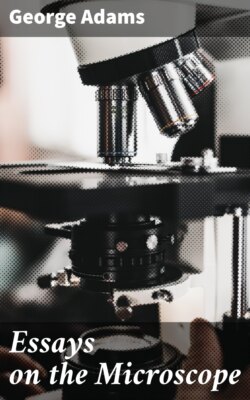Читать книгу Essays on the Microscope - George Comp Adams - Страница 15
На сайте Литреса книга снята с продажи.
Оглавление[27] Encyclopædia Britannica, last edition, vol. xiii, p. 357.
1. The quantity of light lost in passing through the glass.
2. The diminution in the diameter of the glass or lens itself, by which it receives only a small quantity of rays.
3. The extreme shortness of the focal distance of great magnifiers, whereby the free access of the light to the object we wish to view is impeded, and consequently the reflection of the light from it is weakened.
4. The aberration of the rays, occasioned by their different refrangibility.
To make this more clear, let us suppose a lens made of such dull kind of glass, that it transmits only one half the light that falls upon it. It is evident, that supposing this lens to be of four inches focus, and to magnify the diameter of the object twice, and its own breadth equal to that of the pupil of the eye, the object will be four times magnified in surface, but only half as bright as if it was seen by the naked eye at the usual distance; for the light which falls upon the eye from the object at eight inches distance, and likewise the surface of the object in its natural size, being both represented by 1, the surface of the magnified object will be 4, and the light which makes it visible only 2; because, though the glass receives four times as much light as the naked eye does at the usual distance of distinct vision, yet one half is lost in passing through the glass. The inconvenience, in this respect, can only be removed so far as it is possible to increase the transparency of the glass, that it may transmit nearly all the rays which fall upon it; and how far this can be done, has not been yet ascertained.
The second obstacle to the perfection of microscopic glasses, is the small size of great magnifiers; by which means, notwithstanding their near approach to the object, they receive a smaller quantity of light than might be expected. Thus, suppose a glass of only one-tenth of an inch focal distance, such a glass would increase the visible diameter eighty times, and the surface 6400 times. If the breadth of the glass could at the same time be preserved as great as the pupil of the eye, which we shall suppose one-tenth of an inch, the object would appear magnified 6400 times, and every part would be as bright as it appears to the naked eye. But if we suppose the lens to be only 1⁄20 of an inch diameter, it will then only receive one-fourth of the light which would otherwise have fallen upon it; therefore, instead of communicating to the magnified object a quantity of light equal to 6400, it would communicate an illumination suited only to 1600, and the magnified object would appear four times as dim as it does to the naked eye. This inconvenience can, however, in a great degree be removed, by throwing a much larger quantity of light on the object. Various methods of effecting this purpose will be pointed out in the course of this work.
The third obstacle arises from the shortness of the focal distance in large magnifiers; this inconvenience can, like the former, be remedied in some degree, by artificial means of accumulating light; but still the eye is strained, as it must be brought nearer the glass than it can well bear, which in some measure supersedes the use of very deep lenses, or such as are capable of magnifying beyond a certain degree.
The fourth obstacle arises from the different refrangibility of the rays of light, which frequently causes such deviations from truth in the appearance of things, that many have imagined themselves to have made surprising discoveries, and have communicated them as such to the world; when, in fact, they have been only so many optical deceptions, owing to the unequal refraction of the rays. In telescopes, this error has been happily corrected by the late Mr. Dollond’s valuable discovery of achromatic glasses; but how far this invention is applicable to the improvement of microscopes, has not yet been ascertained; and, indeed, from some few trials made, there is reason for supposing they cannot be successfully applied to microscopes with high powers; so that this improvement is yet a desideratum in the construction of microscopes, and they may be considered as being yet far from their ultimate degree of perfection.[28]
[28] How many useful and ingenious discoveries have arisen from accidental circumstances? To adduce one recent instance only—Aerostation, a science, which after having baffled the skill and ingenuity of philosophers for a series of years, and by many illiterate persons deemed an idea bordering on absurdity, has been of late discovered, and successfully applied to practice. Edit.
